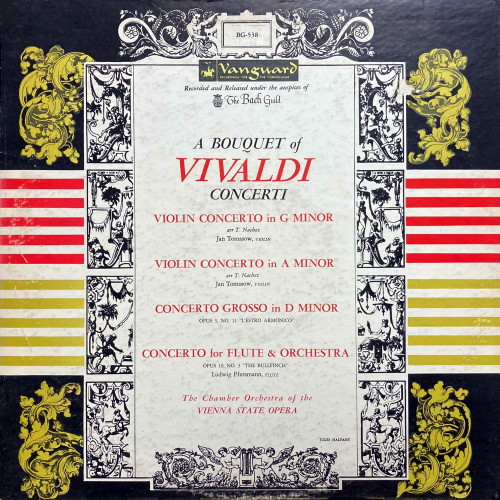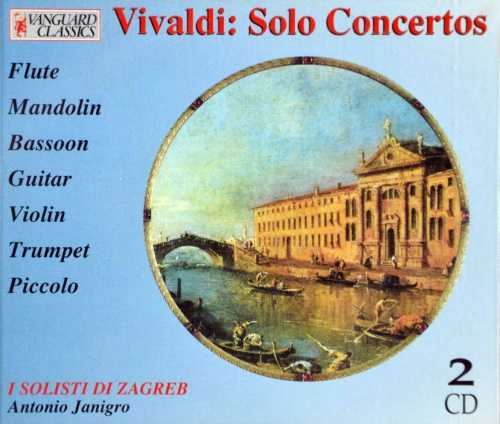 |
|
1 LP -
BG-536 - (p) 1954
|
 |
| 2 CDs -
08 9132 72 - (p) & (c) 1993 |
|
A BOUQUET OF
VIVALDI
|
|
|
|
|
|
|
|
| Antonio VIVALDI (1687-1741) |
Violin
Concerto in G minor (arr. T.
Nachez), Op. 12, No. 1 - RV 317
|
* |
13' 28" |
A1 |
|
-
I. Allegro (4' 33")
· II. Adagio (5'
17") · III. Allegro (3' 38")
|
|
|
|
|
Violin Concerto
in A minor (arr. T. Nachez),
Op. 3, No. 6 - RV 356
|
* |
9' 16" |
A2
|
|
-
I. Allegro (3' 47")
· II. Largo (2'
27") · III. Presto (3' 02")
|
|
|
|
|
Concerto Grosso
in D minor, Op. 3, No. 11,
"L'estro armonico" - RV 565
|
*/**/°°
|
10' 35" |
B1 |
|
-
I. Allegro-Adagio
spiccato-Allegro-Adagio (4' 48") · II.
Largo e spiccato (2'
35") · III. Allegro (3' 12")
|
|
|
|
|
Concerto for
Flute and Orchestra, Op. 10, No. 3,
"Bullfinch" (Cardellino) - RV 248
|
°
|
9' 58" |
B2 |
|
-
I. Allegro (4' 09")
· II. Solo cantabile (2' 40") · III.
Allegro (3' 09")
|
|
|
|
|
|
|
|
|
| Jan
Tomasow, violin *
|
CHAMBER ORCHESTRA
OF THE VIENNA STATE OPERA
|
|
Wilhelm Huebner,
violin **
|
|
|
Ludwig Pfersmann,
flute °
|
|
|
George Harand,
'cello °°
|
|
|
| Gustav Leonhardt,
cembalo |
|
|
|
|
|
|
Luogo
e data di registrazione |
|
Brahmssaal,
Musikverein, Vienna (Austria) -
1953 |
|
|
Registrazione: live
/ studio |
|
studio |
|
|
Producer |
|
Seymour Solomon
|
|
|
Engineer
|
|
-
|
|
|
Prima Edizione LP |
|
Vanguard - The Bach
Guild | BG-538 | 1 LP - durata 43'
17" | (p) 1954
|
|
|
Edizione CD |
|
Vanguard Classics |
08 9132 72 | 2 CDs - durata 66'
01" - 63' 09" | (p) & (c) 1993
| ADD | Only Concerto RV 317
|
|
|
Cover Art
|
|
Jules Halfant
|
|
|
Note |
|
Billboard, 21 August
1954
|
|
|
|
|
The Venice in
which Antonio Vivaldi
(1680-1743) lived and worked
was a flourishing center of
music. In 1637 Venice opened
the first publich opera
house, taking opera from
Florence and Rome, where it
has been a refined court
entertainment, and making it
into a sumptuous popular
spectacle. The four city Ospedali,
or orphanges, became budding
conservatories, in each of
which some forty to sixty
girls were trained in music
and soon some of the finest
choral and instrumental
music in Italy was being
heard at these Ospedali,
of which the most eminent
musicians were proud to be
directors.
It was with the Ospedale
della Pieta, one of
the oldest of these
institutions, that Vivaldi
was associated as director
for most of his career. A
famous violinist, like
Corelli who preceded him and
Tartini who followed him,
and the first to explore the
possibilities of the solo
violin concerto, he was also
one of the most poetic and
imaginative of composers. He
was a true Venetian. The
great artists who had
painted the splendors and
gathering shadows of the
Venetian Republic of a
century before, such as
Giorgione, Titian, Veronese
and Tintoretto, had been
distinguished for their joy
in life and love of nature,
expressed in a radiance of
color. They had been known
as the "impressionists" of
the Renaissance and Vivaldi
was one of the first great
tono colorists of orchestral
music, combining winds and
strings with a sensitivity
and freedom previously
unknown in the concerto. The
poetic bent of his mind may
be seen in the titles of
many of his concertos: Il
Sospetto, La notte,
Madrigalesco, L'inquietudine,
Alla rustica, Per
la S.S. Assunzione di
Maria Vergine, Le
Quattro Stagioni, Il
Cardinello.
Because of the nature
pictures of his music,
Vivaldi is often referred to
by music historians as one
who foreshadowed 19th
century romantic music. But
while his influence on the
development of music is
great, he is whally a genius
of his times. His sweetly
singing "Bullfinch" has much
in common with the cuckoo
that sings in Beethoven's Pastoral
Symphony, but has no
relation to the
philosophical forest bird of
Wagner's Siegfried,
Vivaldi's inspiration came
in part from the opera of
his own time, to which he
himself contributed
thirty-eight works. and when
we learn that Venetian opera
was famous for its scenes of
pastoral idylls, dreams,
incantations, storms,
shipwrecks, and battles, we
need look no further for the
poetic and colorful quality
of his music. In his
instrumental works, Vivaldi
did not try to point
pictures or tell a story.
What he tried most of ait to
capture in music was a
feeling of the sensitive
awakening of the human being
to the oalor and movement of
life, with both pathos and
joy. This was reflected not
only in his iridescent tone
colors, but also in his
beauty of singing melody and
estraordinary plasticity of
form. As against the
episodic and strict
regularity of Corelli's
concertos, Vivaldi makes the
concerto form a malleable
thing in his hands, yet
always giving it an inner
logic. It was this form that
so attracted Johann
Sebastian Bach who took
Vivaldi's concertos as the
definitive form an which he
modelled his own Brandenburg
Concertos and solo
concertos. Bach transcribed
mani of Vivaldi's concertos
in the process of studying
them, arranging six of the
works in L'estro
armonico for organ and
for clavier with orchestra.
This record brings together
four of the most attractive
Vivaldi concertos. The two
solo violin concertos, in G
minor and A minor, are
played with the bass
realized by Tivadar Nachez,
the eminent concert
violinist of the late 19th
century. The D minor
concerto for two violins and
strings, heard here in its
original form, is one of the
Vivaldi works transcribed by
Bach for organ. It's lovely
slow movement has also
became a violinist's and
'cellist's encore piece. The
"Bullfinch" concerto is one
of the classic works for
flute, ranking with but
entirely different from
Mozart's concertos for this
instrument, and is also one
of the most engaging of
Vivaldi's nature pieces.
The G minor concerto for
violin and orchestra is No.
1 of Vivaldi's Op. 12, a
collection of six solo
concertos published in
Amsterdam in 1727-34. It
belongs in the great line of
solo violin concertos, and
is distinguished by its deep
emotional content and
organic form. In the first
movement, Vivaldi departs
from the Corelli concerto
from with its regular
alternation of tutti
and solo passages, each with
its own material. Here the tutti
passages link up with the
solos, thus gibing the
entire movement a dramatic
life and continuity. The
slow movement is unusually
broad even for Vivaldi, with
weaving violin arabesques
creating a melodic line of
hauting and plastic beauty.
The last movement returns to
the first movement form, but
with lighter, dance-like
themes.
The A minor concerto, for
solo violin and orchestra,
is No. 3 of Vivaldi's Op. 6,
L'estro armonico, the
collection of twelve
concertos published in 1700.
It resembles the G minor
concerto in form but is not
as broad in scope. again
there is, in the first
movement, a definite link
between the tutti
theme and the solo passages,
which use the tutti
as a spring-board. The slow
movement is a lovely aria,
and the last movement is in
characteristic dance rhythm.
The D minor Concerto Grosso,
Op. 3, No. 11 L'estro
armonico, indicates
how frealy Vivaldi deported
from the form he himself had
developed. The title of the
set, which has been
translated as "harmonious
rapture", is a clue to the
exciting explorations of
modulation and the
structural use of harmony
upon which Vivaldi embarks
here. The first movement
immediately introduces the
two solo violins, in
brilliant figurations
powerfully built up over a
sustained D in the lower
orchestral voices. A short adagio
of solemn chords follows,
and then there is a fugue,
with the first two entries
of the subject announced by
the orchestra and the next
two by the soloists. The largo
is one of Vivaldi's most
beautiful melodies in siciliana
rhythm. The last movement
like the first, starts with
a brilliant declamation by
the soloists. And like the
first movement, it exhibits
Vivaldi as a marvellous
orchestrator, for what we
have is not so much a
concerto for two violin
soloists as an essay in the
subtle variations of color
possible in the interplay of
smaller and larger bodies of
strings.
The Concerto for flute and
orchestra, Op. 10, No. 3,
called Il Cardellino
or "The Bullfinch", is also
a masterpiece of
instrumental color and
novelty of form. The solo
flute announces itself at
the beginning, chirping an
antiphonal answer to the tutti.
It then develops its own
full-throated song, joined
by the concertino of
solo strings, which trill in
company with it. The entire
movement is an increasingly
free development of the
lyrical voice of the flute,
until the opening tutti
theme announces the end. The
slow movement is a sweet siciliana.
In the last movement Vivaldi
achieves the most subtle
variety of colors with is concertino
group of flute and strings,
in interplay with the full
body of the orchestra.
Notes
by S. W. Bennett
About the
Performers
The Chamber
Orchestra of the Vienna State
is made up of some of the most
proficient instrumentalists in
Europe, molded together into a
group whose prowess can be
seen in the unity of spirit of
this conductorless
performance. Gustav Leonhardt,
at the cembalo, is an
outstanding Dutch
musicologist, cembalo player
and organist, famous for his
newly studied performances of
Bach's Art of Fugue
and Goldberg Variations,
and a professor of musicology
and the cembalo at the Vienna
Academy of Music. Jan Tomasow
is the extraordinary solo
violinist whose Vanguard
recordings of Mozart's
Divertimenti, K. 287 and K.
334, have won the enthusiastic
praise of American critics,
such as the N. Y. Herald
Tribune's "Mozart played this
way is a treat hard to match."
|
  |
|
|